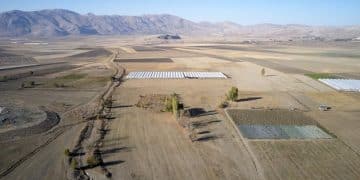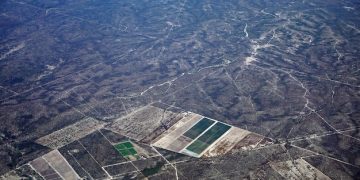Economic Benefits of 100% Renewable Energy in the US by 2050

Transitioning to a 100% renewable energy economy in the US by 2050 could yield substantial economic benefits, including job creation, reduced healthcare costs, energy independence, and increased economic growth, driven by investments in renewable energy technologies and infrastructure.
The prospect of a 100% renewable energy economy in the United States by 2050 is gaining traction, not just as an environmental imperative but also as a potential economic boon. The potential economic benefits of transitioning to a 100% renewable energy economy in the US by 2050 are multifaceted and could reshape the nation’s economic landscape.
Exploring the Economic Potential of Renewable Energy Transition in the US
Transitioning to 100% renewable energy in the US by 2050 isn’t just an environmental goal; it’s an economic opportunity. This transition could unlock significant economic benefits, transforming various sectors and improving the nation’s overall financial health.
Job Creation in the Renewable Energy Sector
One of the most significant economic benefits is the creation of new jobs. The renewable energy sector is inherently labor-intensive, requiring skilled workers for manufacturing, installation, maintenance, and research.
- Manufacturing Jobs: Building solar panels, wind turbines, and other renewable energy components will create manufacturing jobs across the country.
- Installation and Maintenance: These jobs are crucial for deploying and maintaining renewable energy infrastructure, often located in rural areas.
- Research and Development: Investing in R&D for renewable energy technologies fosters innovation and high-skilled jobs.
These jobs often offer competitive wages and benefits, contributing to local economies and providing stable employment opportunities. Investing in training programs to prepare workers for these jobs is essential to maximize this benefit.

Reduced Healthcare Costs and Improved Public Health
Beyond direct economic gains, switching to renewables can significantly reduce healthcare costs. Fossil fuels contribute heavily to air pollution, which leads to numerous health problems.
The Health Impacts of Fossil Fuels
Burning fossil fuels releases pollutants that cause respiratory illnesses, cardiovascular diseases, and even cancer. These health issues strain the healthcare system and reduce productivity.
- Reduced Air Pollution: Renewable energy sources like solar and wind produce little to no air pollution, improving air quality.
- Fewer Respiratory Illnesses: Cleaner air means fewer cases of asthma, bronchitis, and other respiratory problems.
- Lower Healthcare Spending: Reduced illness rates translate to lower healthcare costs for individuals and the government.
By cleaning up the air, a transition to renewable energy can improve public health, reduce healthcare costs, and increase overall quality of life. This represents a substantial economic benefit that is often overlooked.
Achieving Energy Independence and Security
Reliance on fossil fuels, especially those imported from unstable regions, poses risks to national security. Transitioning to renewable energy can enhance energy independence, protecting the US economy from global market fluctuations.
Domestic Energy Production
Renewable energy sources are abundant across the US. Solar, wind, geothermal, and hydropower can be harnessed locally, reducing the need for imported fuels.
Investment in renewable energy infrastructure creates a distributed and resilient energy system. This reduces vulnerability to disruptions caused by geopolitical events or natural disasters.
Increasing energy independence enhances national security and protects the economy from volatile global energy markets.
Furthermore, creating a domestic renewable energy industry stimulates economic growth and ensures a more stable energy supply.
Stimulating Economic Growth Through Innovation
Investing in renewable energy technologies drives innovation and technological advancements. This creates new industries, attracts investment, and boosts economic growth.

Renewable energy generates substantial economic growth, and it is also a good investment.
The Role of Research and Development
Investment in R&D leads to breakthroughs in energy storage, grid management, and renewable energy generation.
These advancements create new business opportunities and high-paying jobs in the technology sector.
Transitioning to renewable energy stimulates a green economy, attracting foreign investment and enhancing the US’s competitive edge.
By fostering innovation, the transition to renewable energy can drive long-term economic growth and create a more sustainable economy.
Impact on the US Energy Market Analysis
The US energy market is poised for significant transformation with the shift towards renewable energy, involving the energy price reduction, and increase on competitivity.
Renewables and Market Transformation
Transitioning to renewable energy can stabilize energy prices by reducing reliance on volatile fossil fuel markets.
A diversified energy mix improves grid resilience and reduces the risk of price spikes.
Policies supporting renewable energy deployment can create predictable investment environments, attracting capital and driving growth.
Analysis of the US energy market under a 100% renewable scenario reveals a more stable, sustainable, and economically beneficial energy landscape.
The Importance of Policy and Investment
Achieving a 100% renewable energy economy requires strategic policies and investments. Government support plays a crucial role in accelerating the transition and maximizing the economic benefits.
Subsidies, tax credits, and regulations can incentivize renewable energy deployment and attract private investment.
Investing in grid infrastructure and energy storage is essential for integrating renewable energy sources into the grid.
Supporting workforce development programs ensures that workers have the skills needed to succeed in the renewable energy sector.
With the right policies and investments, the US can unlock the full economic potential of a 100% renewable energy economy, ensuring a prosperous and sustainable future.
The transition to a renewable energy economy can bring economic prosperity to the US.
| Key Point | Brief Description |
|---|---|
| ⚙️ Job Creation | New jobs in manufacturing, installation, maintenance, and R&D of renewable energy technologies. |
| 🩺 Reduced Healthcare Costs | Improved air quality leads to fewer respiratory illnesses and lower healthcare spending. |
| 🛡️ Energy Independence | Reduced reliance on imported fossil fuels enhances national security and economic stability. |
| 💡 Innovation and Growth | Investment in R&D drives technological advancements, creating new industries and high-paying jobs. |
What are the main economic benefits of transitioning to renewable energy?
▼
Transitioning to renewable energy creates jobs, reduces healthcare costs, enhances energy independence, and stimulates economic growth through innovation and investment in new technologies.
▼
Renewable energy sources produce little to no air pollution, leading to fewer respiratory illnesses and cardiovascular diseases, thus reducing healthcare costs for individuals and the government.
▼
Energy independence reduces reliance on volatile global fossil fuel markets, enhancing national security and economic stability by ensuring a more predictable energy supply.
▼
Government policies such as subsidies, tax credits, and regulations incentivize renewable energy deployment, attract private investment, and support workforce development programs in the sector.
▼
Investment in renewable energy technologies fosters innovation in energy storage, grid management, and energy generation, creating new business opportunities and high-paying jobs in the technology sector.
Conclusion
Transitioning to a 100% renewable energy economy in the US by 2050 presents a significant economic opportunity. By focusing on job creation, healthcare cost reduction, energy independence, and innovation, the US can unlock substantial economic benefits and build a more sustainable future.





